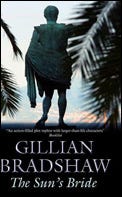Rhodes in 246 B.C. is the setting of Gillian Bradshaw's novel The Sun's Bride. Rhodes is an island in the Aegean Sea between Greece and Turkey, once home to the Colossus of Rhodes, one of the celebrated "Seven Wonders of the Ancient World." Bradshaw lets us glimpse the Colossus, but gives it short shrift, preferring to focus on piracy, foreign relations and naval derring-do. As she says in the Author's Note: "Rhodes was … a maritime republic which punched above its weight due to its importance to trade. Its influence actually extends to the present day; the 'Rhodian Law' is the basis of all codes of maritime law ever since."
Her fictional hero, Isokrates, is the helmsman of the Atalanta, a ship designed to seek out and destroy pirate ships by ramming them. "She was a trihemiolia, a 'half-three', with two and a half banks of oars and a hundred and twenty oarsmen." On a training run, the ship encounters a Cretan pirate with a beautiful hostage: "As Atalanta approached, Isokrates saw that the pirate leader had dragged the woman out on top of the oarbox and to the sternpost. She knelt passively, gazing down at the dark blue water under the hemiolia's stern, while he stood over her, holding her by the hair, his knife held out so that they could all see it."
The woman is less passive than she looks, though. When Isokrates discovers to his somewhat astonished relief that he has rescued her, complications ensue. Until recently, Dionysia was the reluctant mistress of King Antiochos II of Syria whose ex-wife, the ruthless Laodike, wants her dead. Isokrates himself runs afoul of the murderous Queen Laodike in a vivid and tense scene, but some of the most interesting developments in The Sun's Bride take place offstage as the kings of Egypt, Syria and Macedon jockey for power while little, republican Rhodes tries to survive in their midst. (2008, 231 pages)




